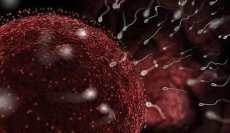New publications
Seminal fluid increases the likelihood of conception
Last reviewed: 01.07.2025

All iLive content is medically reviewed or fact checked to ensure as much factual accuracy as possible.
We have strict sourcing guidelines and only link to reputable media sites, academic research institutions and, whenever possible, medically peer reviewed studies. Note that the numbers in parentheses ([1], [2], etc.) are clickable links to these studies.
If you feel that any of our content is inaccurate, out-of-date, or otherwise questionable, please select it and press Ctrl + Enter.

A protein has been found in seminal fluid that affects the female hormonal system, increasing the likelihood of conception.
Most animals ovulate according to an internal schedule - the menstrual cycle. The egg matures regardless of the female's sexual activity. The same thing happens in humans, and this allows (in the absence of more reliable contraceptives) to organize one's own sexual life in such a way as to avoid pregnancy.
But in some animals (such as rabbits and camels), ovulation can be accelerated by sexual contact. For a long time, it was believed that the signal here was physical stimulation of the female reproductive tract during mating. However, in 1985, a hypothesis was put forward that seminal fluid itself, without any physical stimulation, can accelerate the maturation of the egg. A few years ago, researchers from the University of Saskatchewan (Canada) tried to confirm this theory. They injected male seminal fluid into the hind legs of female llamas, and the llamas actually began to ovulate.
The scientists then spent nearly seven years trying to find the key molecule in semen that was so effective at tweaking the females’ hormonal systems. They took sperm samples from llamas (who, like camels, ovulate when they have sex) and bulls (whose females seem to ovulate independently of such “external factors”). The sperm were separated and the remaining fluid was fractionated using a variety of methods, including filtration, heat, and enzyme digestion. After each attempt, the treated semen (or rather, what was left of it) was injected into the females to see if the key molecule had been destroyed.
As a result, as the researchers write in the journal PNAS, they were met with a surprising result: instead of an unknown protein, the scientists had the well-known nerve growth factor (NGF) in their hands. In fact, NGF was discovered in bull semen back in the early 1980s. But then no one knew what to do with this strange fact. Now it is more or less clear why seminal fluid contains a protein necessary for the vital activity of neurons. According to the researchers, they were able to detect NGF in the sperm of a wide variety of species: horses, rabbits, pigs, and even humans. Moreover, the seminal fluid had an interspecies effect: stallion semen could speed up ovulation in llamas, and llama semen could speed up ovulation in mice.
In some animals (for example, cows, which ovulate according to an internal cycle), NGF did not accelerate ovulation. But in this case, it affected the rate of formation of ovarian follicles and stimulated the development and functioning of the corpus luteum - that is, it still affected, albeit indirectly, the processes of the menstrual cycle.
In other words, seminal fluid can really increase the probability of conception at the level of the female hormonal system. True, for this, the nerve growth factor needs to reach the higher parts of the nervous system and interact with the pituitary gland and hypothalamus, and researchers have yet to find out the details of this journey. Well, the most intriguing question that scientists are going to deal with in the near future: how is this the case with humans? Can frequent sexual intercourse reconfigure the female reproductive system for conception, and should we now evaluate the quality of male sperm also by such an indicator as the content of this “nerve” protein?

 [
[